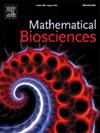肌肉中碳水化合物和蛋白质代谢的数学模型
IF 1.8
4区 数学
Q2 BIOLOGY
引用次数: 0
摘要
我们提出了一个基于耦合常微分方程(ode)的代谢物浓度数学模型,目的是研究对速率的修改如何影响调节网络的输出。我们的目标是模拟能量代谢和非必需氨基酸(如丝氨酸)的生物合成之间的关系。我们考虑细胞质糖酵解、线粒体TCA循环和相关丝氨酸合成途径的网络,目的是模拟代谢重编程作为促进蛋白质合成和生长的机制,特别是在骨骼肌中。我们的目的是探讨过表达两种关键酶,磷酸烯醇丙酮酸羧激酶2 (PCK2)和磷酸甘油脱氢酶(PHGDH)对TCA循环和丝氨酸产生的影响。我们研究了同时上调这两种酶或单独上调每一种酶对丝氨酸合成速率的影响。我们找到了一个依赖于网络输入通量的稳态范围。随着输入通量的改变,稳定状态不再存在,因为它分岔到两种状态之一,在这两种状态中,一些代谢物随时间线性增长,而另一些则衰减到零。渐近分析提供了这些分岔点附近的稳态解的近似,以及参数值的条件,这些参数值决定了系统行为在参数空间中的变化。我们还进行了参数灵敏度分析,以确定扰动对速率常数和输入速率的影响。我们的数值模拟表明,上调PHGDH(丝氨酸合成途径中的初始限速酶)会导致丝氨酸产量增加,但与我们的假设相反,PCK2表达的增加没有影响。该模型有助于我们理解药物的作用和酶表达或活性的变化,这些酶表达或活性在一个途径中上调一个或多个反应。本文章由计算机程序翻译,如有差异,请以英文原文为准。
Mathematical modelling of carbohydrate and protein metabolism in muscle
We propose a mathematical model based on coupled ordinary differential equations (ODEs) for metabolite concentrations with the aim of investigating how modifications to the rates affects outputs from a regulatory network. Our aim is to model the relationships between energy metabolism and the biosynthesis of non-essential amino acids, such as serine. We consider a network of cytosolic glycolysis, the mitochondrial TCA cycle, and the associated serine synthesis pathway, with the aim of modelling the role of metabolic reprogramming as a mechanism to enhance protein synthesis and growth, particularly in skeletal muscle. Our objective is to explore the consequences of overexpressing two key enzymes, phosphoenolpyruvate carboxykinase 2 (PCK2), and phosphoglycerate dehydrogenase (PHGDH), on the TCA cycle and on serine production. We investigate how the rate of serine synthesis is affected by upregulating both enzymes simultaneously, or each one individually. We find a range of steady-states which depend upon input fluxes into the network. As input fluxes are altered, steady states cease to exist due to a bifurcation to one of two states in which some metabolites grow linearly in time whilst others decay to zero. Asymptotic analysis provides approximations for steady-state solutions near these bifurcation points, and conditions on parameter values which determine where in parameter space the system’s behaviour changes. We also perform a parameter sensitivity analysis to determine the effect of perturbations to rate constants and input rates. Our numerical simulations show that the up-regulation of PHGDH, the initial rate limiting enzyme in the serine-synthesis pathway, causes an increase in serine production but that, contrary to our hypothesis, increased expression of PCK2 has no effect. This model aids our understanding of both the effects of drugs and changes in enzyme expression or activities which upregulate one or more reactions in a pathway.
求助全文
通过发布文献求助,成功后即可免费获取论文全文。
去求助
来源期刊

Mathematical Biosciences
生物-生物学
CiteScore
7.50
自引率
2.30%
发文量
67
审稿时长
18 days
期刊介绍:
Mathematical Biosciences publishes work providing new concepts or new understanding of biological systems using mathematical models, or methodological articles likely to find application to multiple biological systems. Papers are expected to present a major research finding of broad significance for the biological sciences, or mathematical biology. Mathematical Biosciences welcomes original research articles, letters, reviews and perspectives.
 求助内容:
求助内容: 应助结果提醒方式:
应助结果提醒方式:


